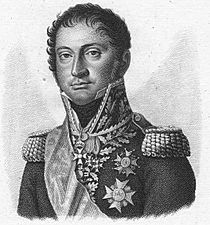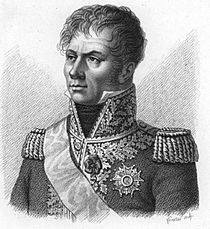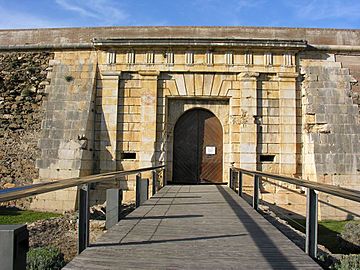Siege of Roses (1808) facts for kids
Quick facts for kids Siege of Roses (1808) |
|||||||
|---|---|---|---|---|---|---|---|
| Part of Peninsular War | |||||||
 Castell de la Trinitat, an outlying fort |
|||||||
|
|||||||
| Belligerents | |||||||
| Commanders and leaders | |||||||
| Strength | |||||||
| 23,000 | 3,500 58 guns 1 third-rate 1 frigate 2 bomb ketches |
||||||
| Casualties and losses | |||||||
| 1,000 | 3,166 58 guns captured |
||||||
The Siege of Roses was an important battle during the Peninsular War in 1808. It took place in the town of Roses in Catalonia, Spain. French and Italian soldiers, led by General Laurent Gouvion Saint-Cyr, surrounded the town and its strong fort. The Spanish defenders, helped by British ships, fought bravely for about a month.
The battle lasted from November 7 to December 5, 1808. The French army, with over 13,000 soldiers, attacked the town and its main fort, called the citadel. The Spanish and Catalan defenders, about 3,500 strong, were led by Peter O'Daly. They also had help from British warships, including one commanded by the famous Captain Thomas Cochrane.
Even with strong defenses and naval support, the French forces slowly gained ground. Eventually, the defenders in the citadel had to surrender. The soldiers and many civilians were captured. This battle was a French victory, but it took them a long time to win. This delay was important for the overall war.
Contents
Why the Battle Happened
The Siege of Roses was part of a bigger conflict called the Peninsular War. This war started when Emperor Napoleon I of France tried to take control of Spain.
Napoleon's Plan for Spain
In 1808, Napoleon wanted to replace the Spanish royal family with his own family members. To do this, he ordered his troops to secretly take over important Spanish cities. One of these cities was Barcelona.
In February 1808, French troops marched into Barcelona. They pretended to be helping Spain fight Portugal. But it was a trick! They suddenly took control of the city's main fort without a fight. The Spanish soldiers inside were surprised and forced out. The French also took other key places like San Sebastián, Pamplona, and Figueres.
However, the Spanish people were very angry about this. On May 2, 1808, they rose up in rebellion against the French.
Early Fights in Catalonia
A French and Italian army, led by General Guillaume Philibert Duhesme, was in charge of Barcelona. They thought they could easily stop the Spanish rebellion in Catalonia. But they were wrong. The local Catalan fighters, called miquelets (militia), fought back fiercely.
In June, French generals were defeated in battles near Bruch and Girona. General Duhesme himself was turned back from Girona. Napoleon realized the rebellion was more serious than he thought. He sent General Honoré Charles Reille with more soldiers to help Duhesme.
First Attack on Roses
General Reille had about 4,000 soldiers and two cannons. He first marched towards the port of Roses. Roses was defended by about 800 regular Spanish soldiers and 400 miquelets. There were also 5,000 more miquelets in the nearby hills.
The British warship HMS Montagu also arrived to help the defenders. On July 11, 1808, Reille attacked Roses, but his troops were pushed back. The French lost 200 soldiers, while the Spanish had few losses.
After failing at Roses, Reille moved to Girona and joined Duhesme. Together, they tried to capture Girona. Meanwhile, Spanish troops from the Balearic Islands landed at Tarragona. They began to surround Barcelona, where Duhesme's soldiers were trapped.
Duhesme's attempt to capture Girona failed. He had to retreat back to Barcelona. His soldiers were tired and hungry. They even had to throw some cannons into the sea and leave their supplies behind. By August 20, Duhesme's army was in a very bad state.
Because of this, Napoleon sent a new general, Laurent Gouvion Saint-Cyr, with a fresh army to help the trapped French soldiers in Barcelona.
The Armies Involved
General Gouvion Saint-Cyr's new army, called the VII Corps, was very large. It had about 42,000 soldiers in total. However, many of these soldiers were already stuck in Barcelona with Duhesme. Gouvion Saint-Cyr had to bring his own divisions to relieve them.
The Spanish army in Catalonia had about 20,000 soldiers. They were led by Captain General Juan Miguel de Vives y Feliu. He had taken over command in October 1808. The Spanish tried to push the French back in November, forcing them to stay behind Barcelona's walls.
The Siege of Roses Begins
Gouvion Saint-Cyr's main goal was to reach Barcelona. But first, he had to deal with Roses. He put General Reille in charge of attacking Roses. Reille had 12,000 French and Italian soldiers for the siege.
The Spanish defenders of Roses had 3,500 soldiers and 58 cannons. Their commander was Colonel Peter O'Daly. Most of the defenders were local miquelets, but there were also some regular Spanish soldiers.
The British Navy also helped. The warship HMS Excellent was there, and later HMS Fame took its place. Two bomb ships, HMS Meteor and HMS Lucifer, also provided support. Later, Captain Cochrane's ship, Imperieuse, joined the fight.
Roses had two main defenses: a large, star-shaped fort called the citadel and a smaller, star-shaped fort called the Castell de la Trinitat. The citadel was a huge, five-sided fort with strong walls. The Castillo de la Trinidad was on a hill about two kilometers away.
On November 8, a thick fog helped the miquelets attack the French. The Spanish garrison also attacked Reille's camp. But these attacks did not stop the French siege. All civilians were taken out of the town by sea that day.
After a week of heavy rain, Reille attacked the Castillo de la Trinidad but was pushed back. The French heavy cannons arrived on November 16, and they started digging places for them. The Spanish commander, de Vives, did not send help to Roses, even though he had many soldiers.
The Fight for the Castle and Citadel
On November 26, Italian soldiers successfully stormed into the town of Roses. This allowed the French to build a cannon battery right on the waterfront, which threatened the British warships. Around this time, the Spanish garrison in Roses received some reinforcements.
On November 28, Reille asked the fortress to surrender, but Colonel O'Daly refused. Captain Cochrane arrived and took command of the Castillo de la Trinidad. This fort was defended by Spanish soldiers and British sailors.
On November 30, the Italian soldiers tried to storm the Castillo again but failed. After this, Reille decided to focus all his efforts on the main citadel instead of the smaller castle.
The French cannons soon created a large hole in the citadel's walls. On December 3, the Spanish commander sent 500 men to attack the French cannons that were making the hole. This attack failed, and the Spanish suffered heavy losses.
By December 4, the French trenches were very close to the citadel walls. They were getting ready for a final, big attack. Seeing this, Colonel O'Daly decided to surrender unconditionally.
On December 5, 2,366 Spanish soldiers laid down their weapons. About 700 more Spanish soldiers were killed or wounded during the siege. At noon on the day of surrender, Captain Cochrane and his men left the Castillo de la Trinidad. They blew up part of the castle with gunpowder to make it unusable for the French. The British ships could not rescue the rest of the Spanish garrison because of heavy French cannon fire. The French and Italian forces lost about 1,000 soldiers to fighting and disease.
What Happened Next
The French had spent a whole month capturing Roses. Now, it was very important for them to reach General Duhesme in Barcelona, who was running out of supplies.
There were two ways to get to Barcelona. The coastal road was blocked and could be attacked by British ships. The inland road was blocked by the strong Spanish defenders of Girona.
General Gouvion Saint-Cyr decided to trick the Spanish. He marched his army in front of Girona, making it look like he was going to attack that city. But then, he sent his cannons and supplies back. The next day, he led his soldiers into the mountains, bypassing Girona completely.
On December 12, his army fought through some miquelets and reached the main inland road. This clever move set the stage for the Battle of Cardadeu on December 16, 1808.
See also




